Signs of the United Nations SDGs in University Curriculum: The Case of the University of Iceland
Abstract
:1. Introduction
1.1. The Role of the SDGs within Universities
1.2. Embedding the SDGs within Higher Education Institutions
1.3. Implementing the SDGs in Universities
2. Method
2.1. The University of Iceland and Sustainability
2.2. Research Methods
3. Results
3.1. Overall Results for the University of Iceland
3.2. Results for Each of the Five Schools of the University of Iceland
3.3. Results by the 17 SDGs
4. Discussion and Conclusions
Author Contributions
Funding
Institutional Review Board Statement
Informed Consent Statement
Data Availability Statement
Acknowledgments
Conflicts of Interest
References
- IPCC [The Intergovernmental Panel on Climate Change]. Global Warming of 1.5 °C. An IPCC Special Report on the Impacts of Global Warming of 1.5 °C Above Pre-Industrial Levels and Related Global Greenhouse Gas Emission Pathways, in the Context of Strengthening the Global Response to the Threat of Climate Change, Sustainable Development, and Efforts to Eradicate Poverty; World Meteorological Organisation: Geneva, Switzerland, 2018; p. 32. [Google Scholar]
- Sterling, S. Planetary Primacy and the Necessity of Positive Dis—Illusion. Sustainability 2019, 12, 60–66. [Google Scholar] [CrossRef]
- Stough, T.; Ceulemans, K.; Lambrechts, W.; Cappuyns, V. Assessing sustainability in higher education curricula: A critical reflection on validity issues. J. Clean. Prod. 2017, 172, 4456–4466. [Google Scholar] [CrossRef]
- Heimsmarkmiðin um Sjálfbæra Þróun. Heimsmarkmiðin. Available online: https://www.heimsmarkmidin.is/forsida/heimsmarkmidin/ (accessed on 21 June 2021).
- United Nations. The 17 Goals. Available online: https://sdgs.un.org/goals (accessed on 18 June 2021).
- United Nations. Transforming our World: The 2030 Agenda for Sustainable Development. Available online: https://sdgs.un.org/2030agenda (accessed on 18 June 2021).
- European Environment Agency. The European Environment—State and Outlook 2020. Executive Summary; Publications Office of the European Union: Luxembourg, 2019; pp. 1–12. [Google Scholar]
- Conceição, P. The 2020 Human Development Report; United Nations Development Programme: New York, NY, USA, 2020. [Google Scholar]
- Leal Filho, W.; Wu, Y.-C.J.; Brandlid, L.L.; Avilae, L.V.; Azeiteirof, U.M.; Caeirog, S.; Madrugah, L.R. Identifying and overcoming obstacles to the implementation of sustainable development at universities. J. Integr. Environ. Sci. 2017, 14, 93–108. [Google Scholar] [CrossRef]
- SDSN [Sustainable Development Solutions Network] Northern Europe. New Guide on Accelerating Education for the SDGs in Universities; Sustainable Development Solutions Network: New York, NY, USA, 2020. [Google Scholar]
- Johannsdottir, L.; Cook, D. Systemic risk of maritime-related oil spills viewed from an Arctic and insurance perspective. Ocean. Coast. Manag. 2019, 79, 1–17. [Google Scholar] [CrossRef]
- Institute of Medicine. The role of universities. In Trends in the Innovation Ecosystem: Can Past Successes Help Inform Future Strategies? Summary of Two Workshops; The National Academies Press: Washington, DC, USA, 2013; pp. 17–24. [Google Scholar]
- Parliament of Iceland. Law on Universities, no 63/2006. Available online: https://www.althingi.is/lagas/nuna/2006063.html (accessed on 5 July 2021).
- University of Duisburg-Essen. Sustainable Development at the University of Duisburg-Essen; University of Duisburg-Essen: Essen, Germany, 2020. [Google Scholar]
- Lozano, R.; Barreiro-Gen, M. Developing Sustainability Competences through Pedagogical Approaches. Experiences from International Case Studies; Springer: Cham, Switzerland, 2021; p. 342. [Google Scholar]
- Leal Filho, W.; Wall, T.; Salvia, A.L.; Frankenberger, F.; Hindley, A.; Mifsud, M.; Brandli, L.; Will, M. Trends in scientific publishing on sustainability in higher education. J. Clean. Prod. 2021, 296, 126569. [Google Scholar] [CrossRef]
- Leal Filho, W.; Shiel, C.; Paço, A.; Mifsud, M.; Ávila, L.V.; Brandli, L.L.; Molthan-Hill, P.; Pace, P.; Azeiteiro, U.M.; Vargas, V.R.; et al. Sustainable Development Goals and sustainability teaching at universities: Falling behind or getting ahead of the pack? J. Clean. Prod. 2019, 232, 285–294. [Google Scholar] [CrossRef] [Green Version]
- SDSN [Sustainable Development Solutions Network]. Getting Started with the Sdgs in Universities: A Guide for Universities—Higher Education Institutions and the Academic Sector; SDSN: New York, NY, USA, 2017. [Google Scholar]
- SDSN [Sustainable Development Solutions Network]. Accelerating Education for the Sdgs in Universities: A Guide for Universities, Colleges, and Tertiary and Higher Education Institutions; SDSN: New York, NY, USA, 2020. [Google Scholar]
- Korhonen-Kurki, K.; Koivuranta, R.; Kuitto, V.; Pietikainen, J.; Schonach, R.; Soini, K. Towards Realising SDGs in the University of Helsinki. In Sustainable Development Goals and Institutions of Higher Education; Nhamo, G., Mjimba, V., Eds.; Sustainable Development Goals Series; Springer: Cham, Switzerland, 2020; pp. 15–29. [Google Scholar]
- Albareda-Tiana, S.; Vidal-Raméntol, S.; Fernández-Morilla, M. Implementing the sustainable development goals at University level. Int. J. Sustain. High. Educ. 2018, 19, 473–497. [Google Scholar] [CrossRef]
- Solís-Espallargas, C.; Ruiz-Morales, J.; Limón-Domínguez, D.; Valderrama-Hernández, R. Sustainability in the University: A Study of Its Presence in Curricula, Teachers and Students of Education. Sustainability 2019, 11, 6620. [Google Scholar] [CrossRef] [Green Version]
- Purcell, W.M.; Henriksen, H.; Spengler, J.D. Universities as the engine of transformational sustainability toward delivering the sustainable development goals. “Living labs” for sustainability. Int. J. Sustain. High. Educ. 2019, 20, 1343–1357. [Google Scholar] [CrossRef] [Green Version]
- Paletta, A.; Fochi, P.; Toschi, T.G.; Ubertini, F. Adoption of the SDGs as a Reporting Framework at the Alma Mater Studiorum (University of Bologna) in Italy. In Sustainable Development Goals and Institutions of Higher Education; Nhamo, G., Mjimba, V., Eds.; Sustainable Development Goals Series; Springer: Cham, Switherland, 2020; pp. 185–197. [Google Scholar]
- Lozano, R.; Barreiro-Gen, M.; Lozano, F.J.; Sammalisto, K. Teaching sustainability in Higher Education Institutions: Assessing the Connections between competences and pedagogical approaches. Sustainability 2019, 11, 1602. [Google Scholar] [CrossRef] [Green Version]
- University of Iceland. The University. Available online: https://english.hi.is/university/the_university (accessed on 18 June 2021).
- The World University Ranking. University of Iceland. Available online: https://www.timeshighereducation.com/world-university-rankings/university-iceland (accessed on 18 June 2021).
- University of Iceland. Háskóli Íslands á Lista Shanghai Ranking fimm ár í röð. Available online: https://www.hi.is/frettir/haskoli_islands_a_lista_shanghai_ranking_fimm_ar_i_rod (accessed on 18 June 2021).
- Stofnun Árna Magnússonar í Íslenskum Fræðum. Culture. Available online: https://www.arnastofnun.is/en/front-page (accessed on 18 June 2021).
- University of Iceland. Lykiltölur—Facts and Figures; University of Iceland: Reykjavík, Island, 2020; pp. 1–76. [Google Scholar]
- University of Iceland. Strategic Plan of the University of Iceland 2011−2016. Available online: http://aldarafmaeli.hi.is/files/policy_2011-2016.pdf (accessed on 18 June 2021).
- University of Iceland. Strategy of the University of Iceland 2016–2021. Available online: https://english.hi.is/university/strategy_of_the_university_of_iceland_2016_2021 (accessed on 18 June 2021).
- University of Iceland. Betri Háskóli Betra Samfélag—Stefna 2021–2026. Available online: https://stefna.hi.is/#Betri-haskoli (accessed on 22 June 2021).
- University of Iceland. Course Catalogue 2019–2020. Available online: https://ugla.hi.is/kennsluskra/index.php?tab=skoli&chapter=content&id=-2019&kennsluar=2019 (accessed on 18 June 2021).
- United Nations. Goals. 1 End Poverty in All Its Forms Everywhere. Available online: https://sdgs.un.org/goals/goal1 (accessed on 5 July 2021).
- United Nations. Goal 1: End Poverty in All Its Forms Everywhere. Available online: https://www.un.org/sustainabledevelopment/poverty/ (accessed on 18 June 2021).
- Whittemore, R.; Chase, S.K.; Mandle, C.L. Validity in Qualitative Research. Qual. Health Res. 2001, 11, 522–537. [Google Scholar] [CrossRef] [PubMed]
- Creswell, J.W. Qualitative Inquiry and Research Design: Choosing Among Five Approaches, 2nd ed.; Sage Publications, Inc.: Thousand Oaks, CA, USA, 2007. [Google Scholar]
- Aalto University. SDGs at Aalto University. Available online: https://www.aalto.fi/en/sustainability/sdgs-at-aalto-university (accessed on 26 June 2021).
- University of Iceland. Aurora. Available online: https://english.hi.is/university/aurora (accessed on 26 June 2021).
- Aurora European University Alliance. Aurora Universities Network. Available online: https://aurora-network.global/ (accessed on 26 June 2021).
- Hallkelsdóttir, H. The UN Sustainable Development Goals in the University of Iceland’s Course Catalogue for School of Education Academic Year 2019–2020: Assessment in each of the University‘s Schools. Master’s Thesis, University of Iceland, Reykjavik, Island, 2020. [Google Scholar]
- Rafnsson, A. The UN Sustainable Development Goals in the University of Iceland’s Course Catalogue for the School of Engineering and Natural Sciences the Academic Year 2019–2020. Master’s Thesis, University of Iceland, Reykjavik, Island, 2020. [Google Scholar]
- Sveinsson, G.M. The UN Sustainable Development Goals in the University of Iceland’s Course Catalogue for School of Health Sciences Academic year 2019–2020. Master’s Thesis, University of Iceland, Reykjavik, Island, 2020. [Google Scholar]
- Bachmann, B. The UN Sustainable Development Goals in the University of Iceland’s Course Catalogue for School of Humanties Academic Year 2019–2020: The UN SDGs Key Competencies. Master’s Thesis, University of Iceland, Reykjavik, Island, 2020. [Google Scholar]
- Jónsdóttir, H.Ó. The UN Sustainable Development Goals in the University of Iceland’s Course Catalogue for the School of Social Sciences for the Academic year 2019–2020: Signs of global Awareness in the Schools of the University. Master’s Thesis, University of Iceland, Reykjavik, Island, 2020. [Google Scholar]
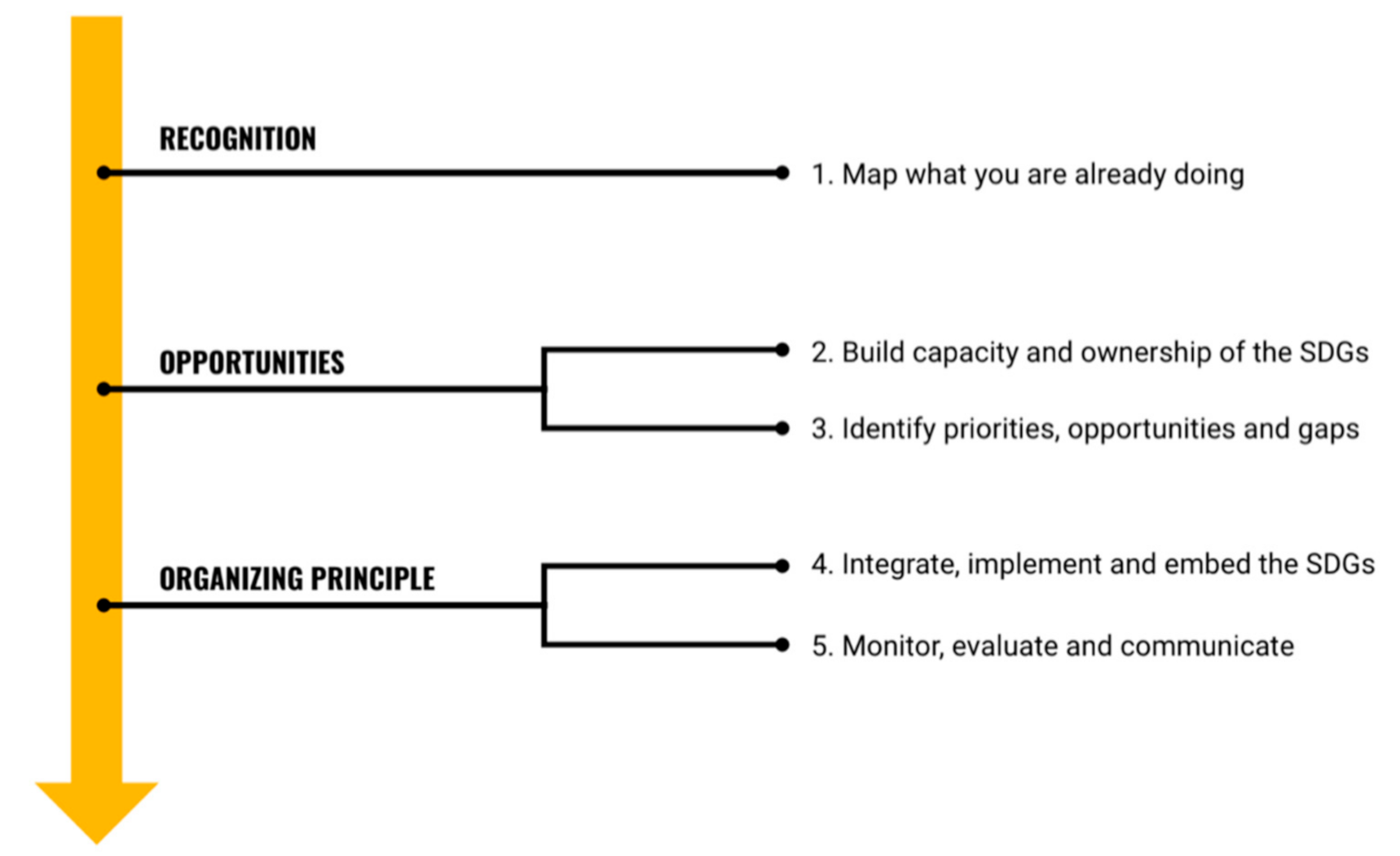
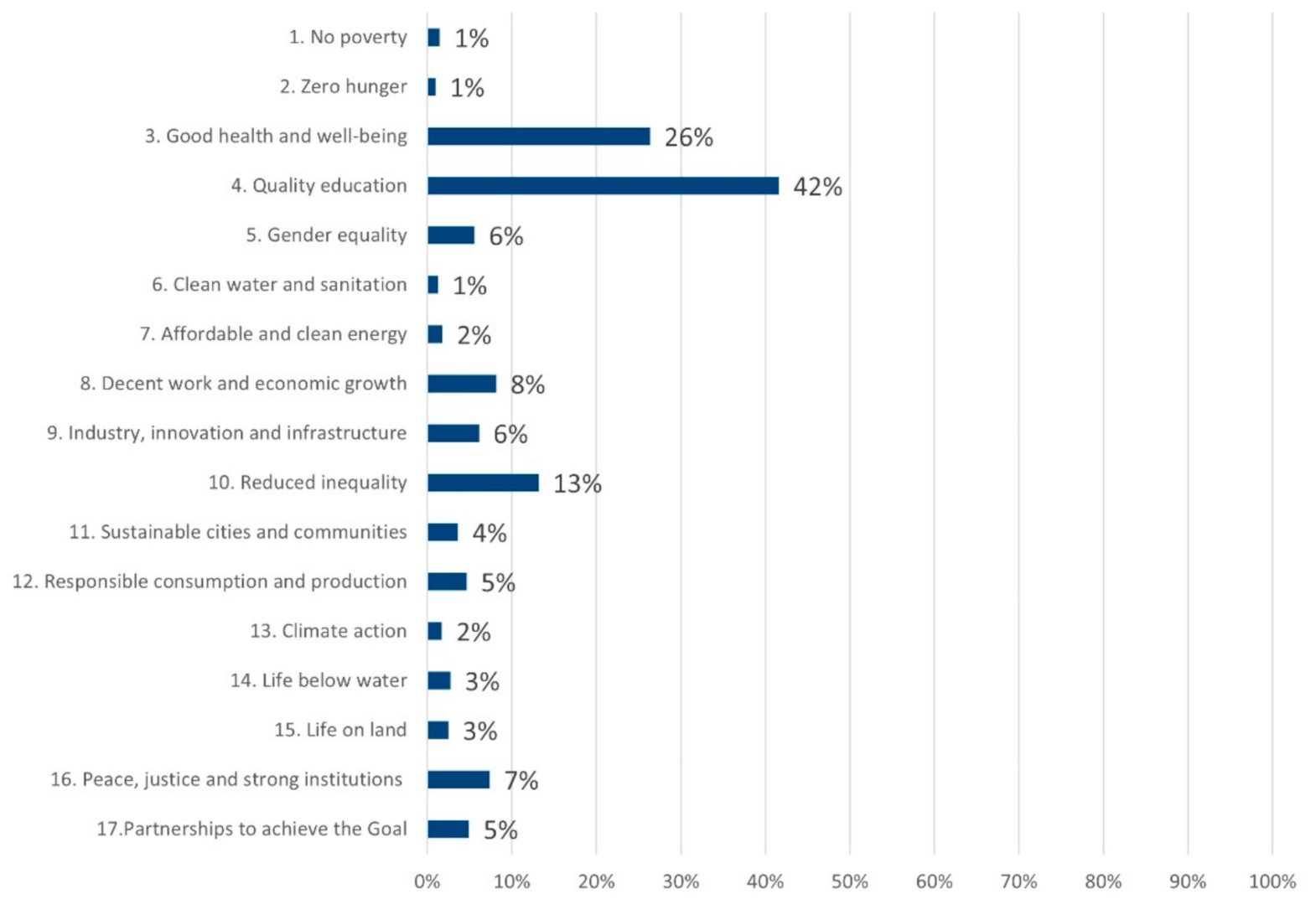
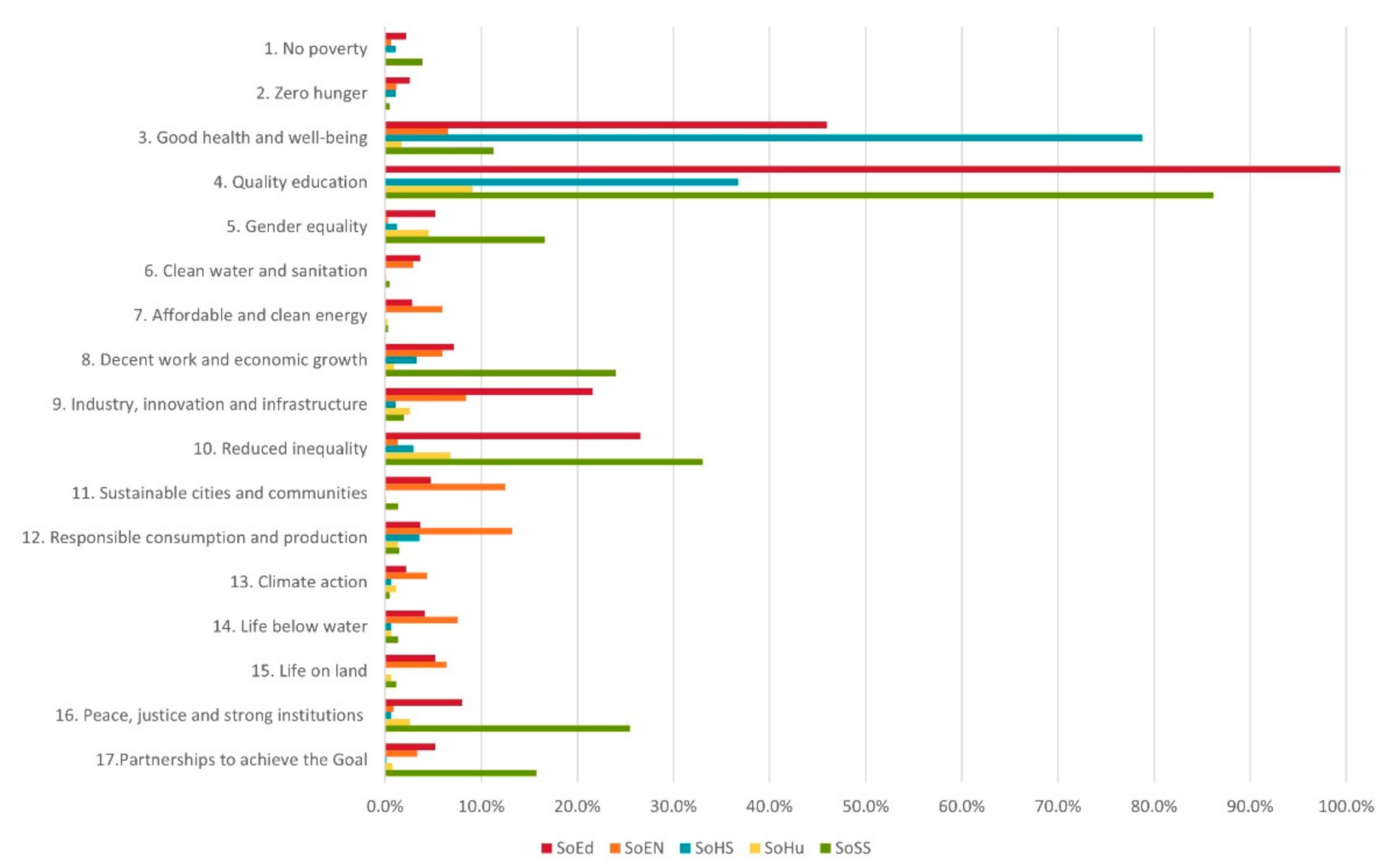
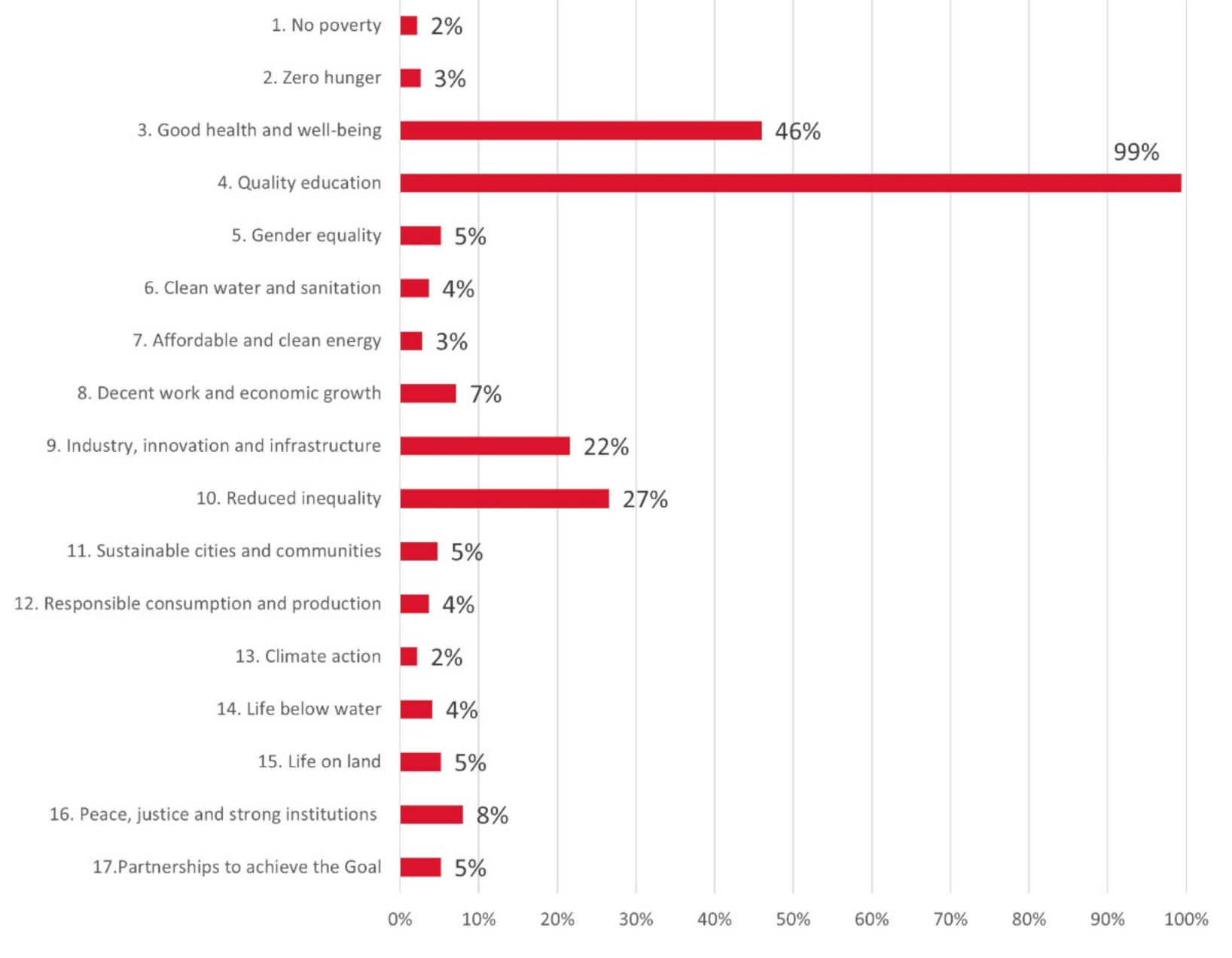
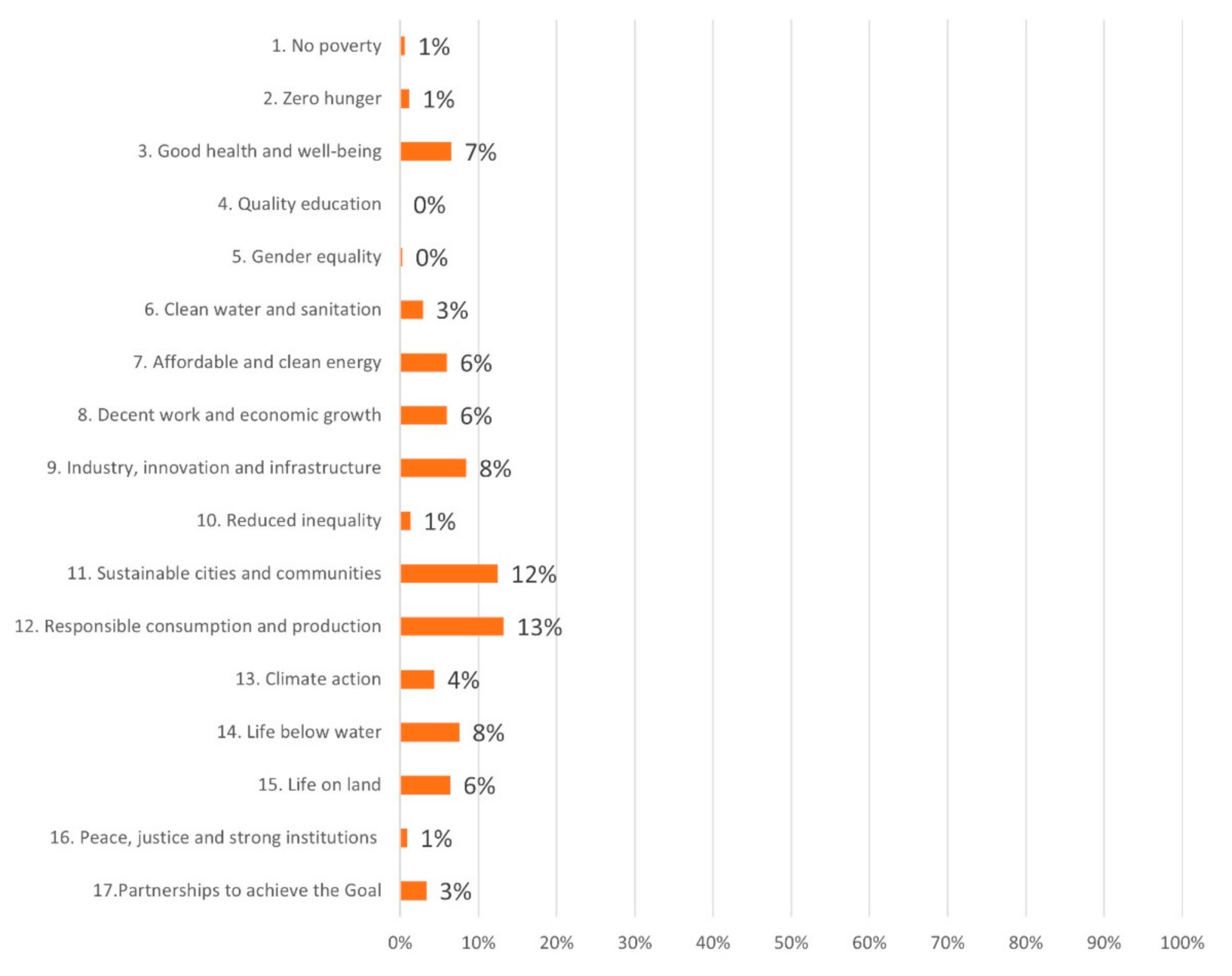
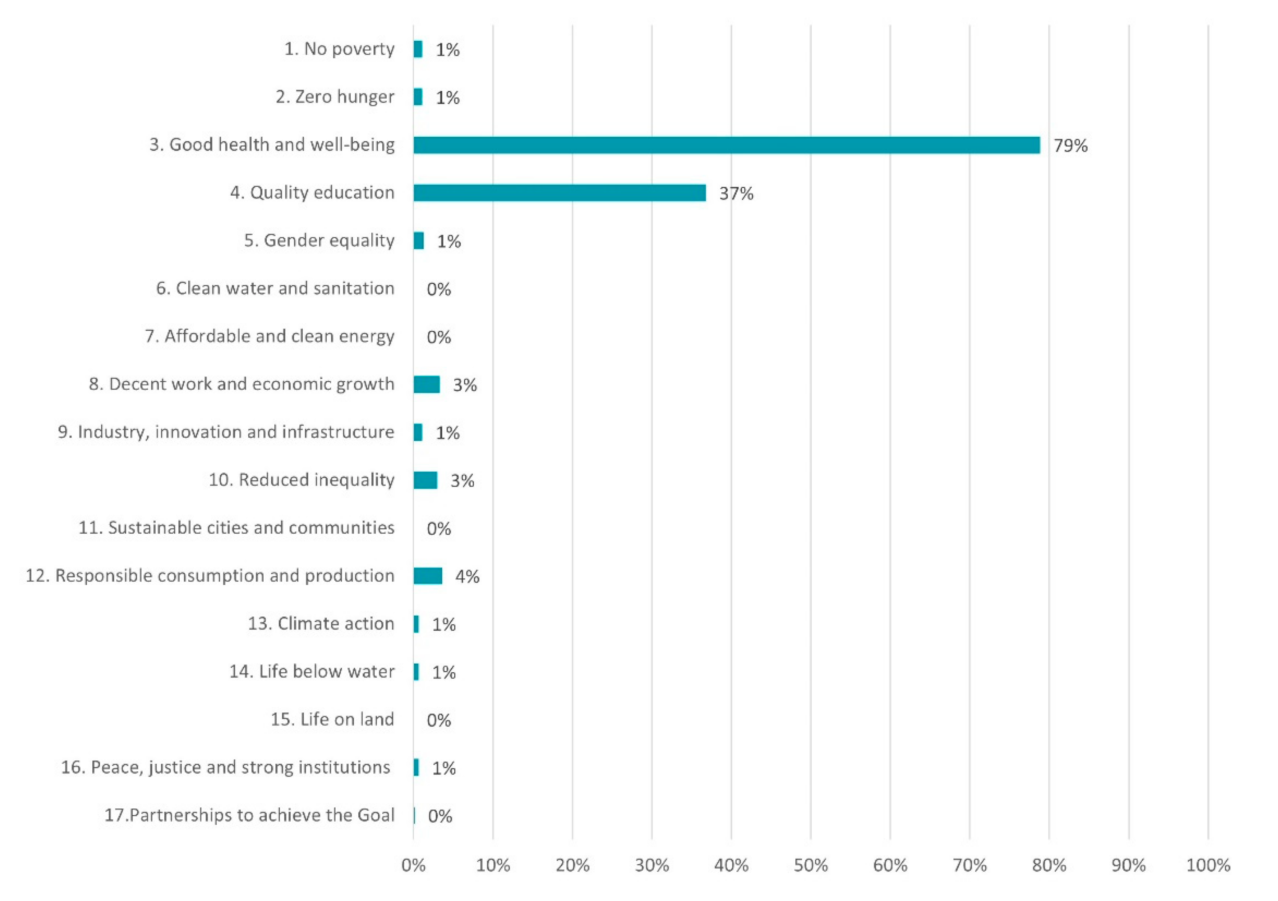
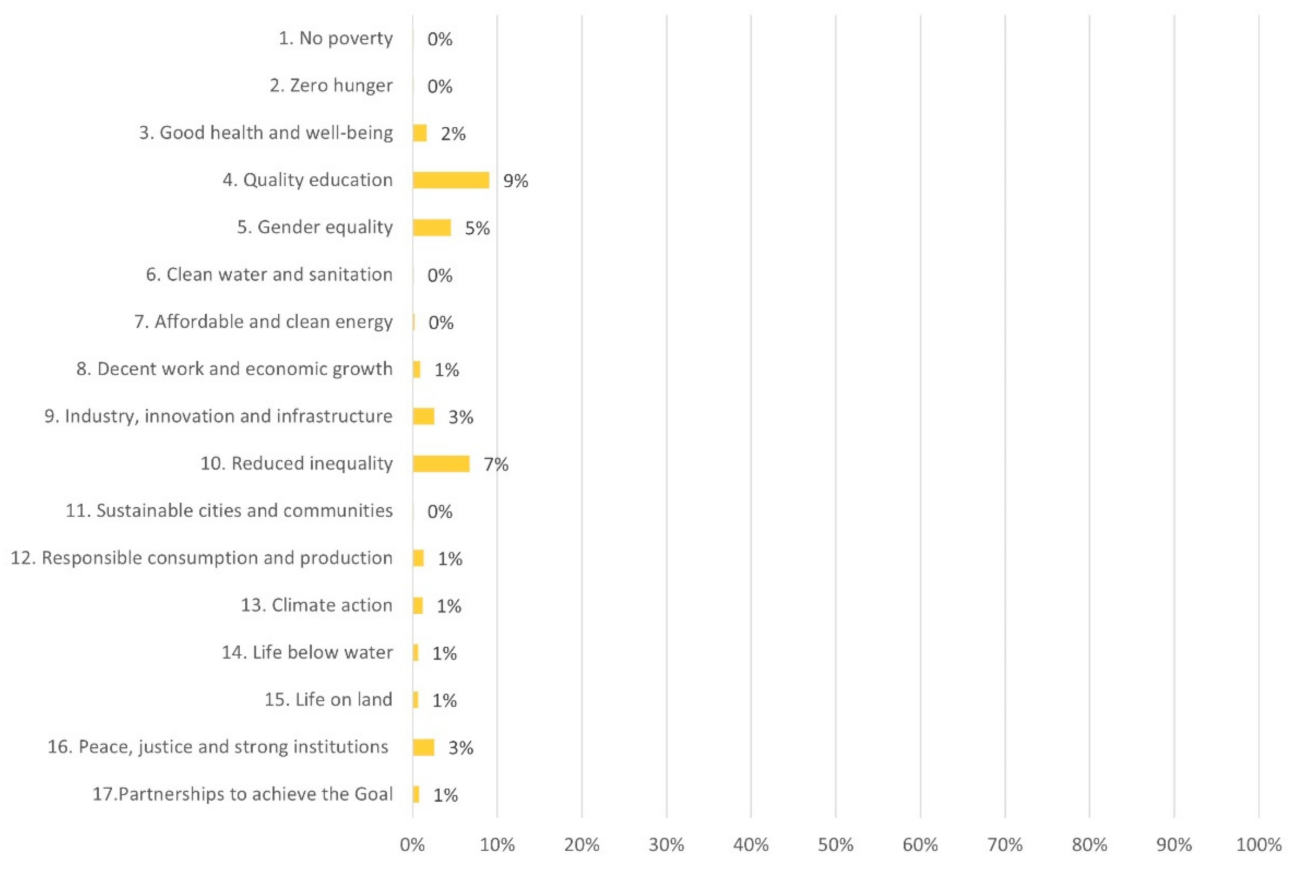




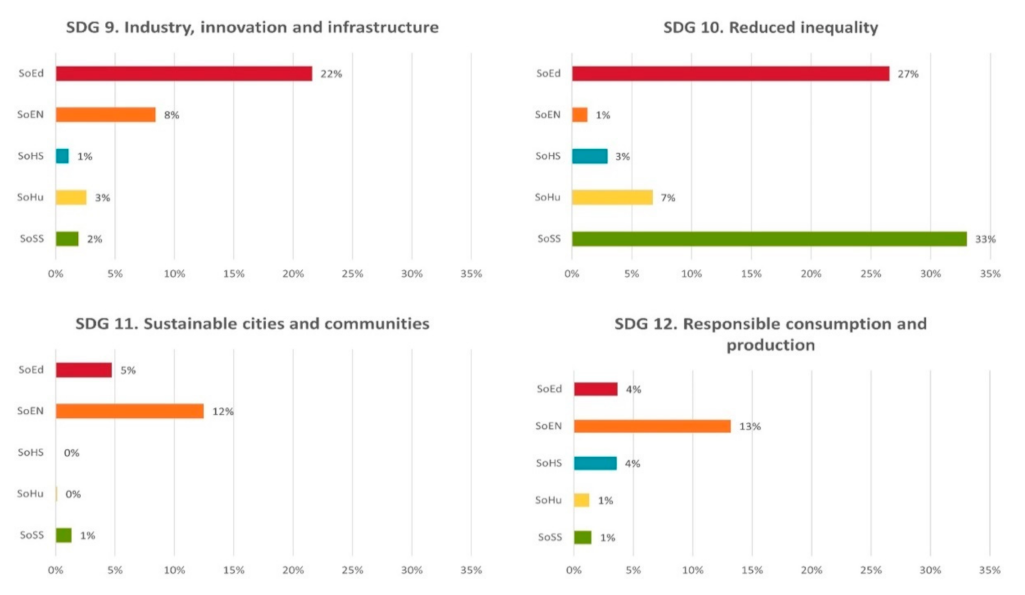
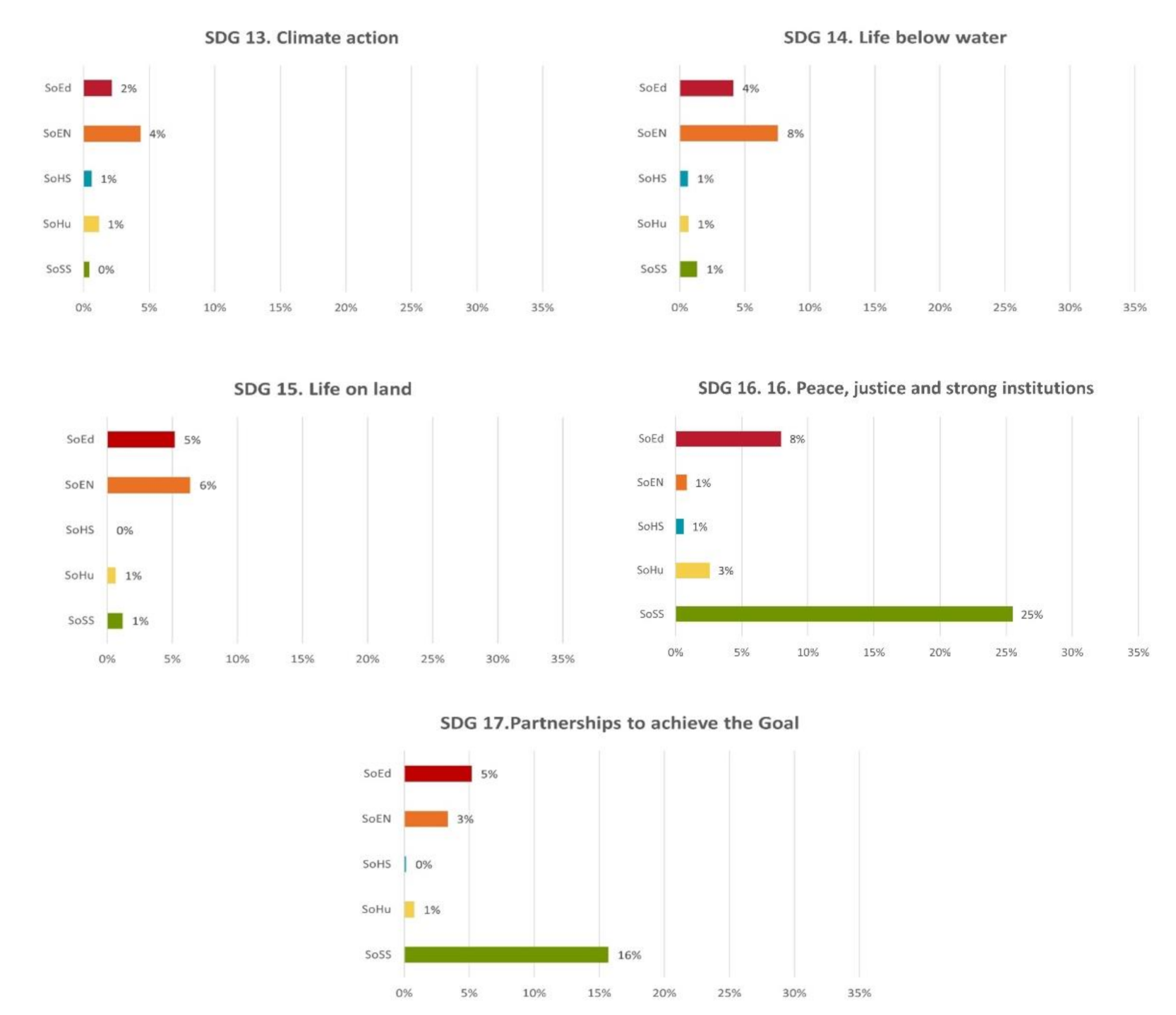
| Data Recording: The UN SDGs and Course Contents in the University of Iceland | Course Language | The Sustainable Development Goals (SDGs) | |||||||||||||||||||
|---|---|---|---|---|---|---|---|---|---|---|---|---|---|---|---|---|---|---|---|---|---|
| NAME OF COURSE | Course number | Number of ECTS | Icelandic | English | 1. No poverty | 2. Zero hunger | 3.Good health and well-being | 4. Quality education | 5. Gender equality | 6. Clean water and sanitation | 7. Affordable and clean energy | 8. Decent work and eco. growth | 9. Industry, innov. & infrastr. | 10. Reducing inequality | 11. Sustainab. cities & commun. | 12. Responsib. consump. & prod. | 13. Climate action | 14. Life below water | 15. Life on land | 16. Peace, justice & strong institut. | 17.Partnerships for the goals |
| Schools | Number of Courses | Number of SDG Signs | Average SDG Signs per Course |
|---|---|---|---|
| SoEd | 463 | 1158 | 2.5 |
| SoEN | 689 | 560 | 0.8 |
| SoHS | 642 | 847 | 1.3 |
| SoHu | 770 | 258 | 0.3 |
| SoSS | 675 | 1519 | 2.3 |
Publisher’s Note: MDPI stays neutral with regard to jurisdictional claims in published maps and institutional affiliations. |
© 2021 by the authors. Licensee MDPI, Basel, Switzerland. This article is an open access article distributed under the terms and conditions of the Creative Commons Attribution (CC BY) license (https://creativecommons.org/licenses/by/4.0/).
Share and Cite
Pálsdóttir, A.; Jóhannsdóttir, L. Signs of the United Nations SDGs in University Curriculum: The Case of the University of Iceland. Sustainability 2021, 13, 8958. https://doi.org/10.3390/su13168958
Pálsdóttir A, Jóhannsdóttir L. Signs of the United Nations SDGs in University Curriculum: The Case of the University of Iceland. Sustainability. 2021; 13(16):8958. https://doi.org/10.3390/su13168958
Chicago/Turabian StylePálsdóttir, Auður, and Lára Jóhannsdóttir. 2021. "Signs of the United Nations SDGs in University Curriculum: The Case of the University of Iceland" Sustainability 13, no. 16: 8958. https://doi.org/10.3390/su13168958
APA StylePálsdóttir, A., & Jóhannsdóttir, L. (2021). Signs of the United Nations SDGs in University Curriculum: The Case of the University of Iceland. Sustainability, 13(16), 8958. https://doi.org/10.3390/su13168958






